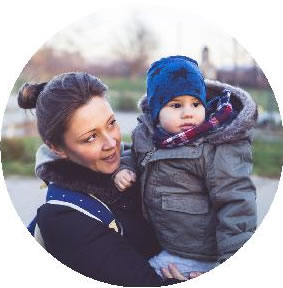What are neonatal
stem cells?
The exploration and understanding of
stem cells is leading to many medical innovations and
ongoing scientific advances. Neonatal stem cells hold
immense healing potential, making their remarkable
abilities a valuable resource for life.
Stem Cell Basics
Stem cells, with their remarkable ability to transform into different types of cells such as blood, bone and muscle cells, play a vital role in the growth, development and repair of tissues in organisms. These innate cells hold the key to treating a multitude of diseases and conditions, transforming modern medicine with regenerative therapeutic options, offering families hope for the future of their health.

Types of Neonatal Stem Cells
When your baby is born, stem cells can be found in the umbilical cord and placenta. These two elements of birth are often discarded, but these cells have immense healing power.
Newborn stem cells derived from umbilical cord blood, umbilical cord tissue, and placental tissue provide a rich source of stem cells with immense therapeutic potential. These cells can be classified into two broad types:
- hematopoietic stem cells (HSCs)
- mesenchymal stem cells (MSCs).
What can stem cells be used for?
Cord blood stem cells are currently used to treat more than 80 conditions and diseases.
These cells, along with stem cells from umbilical cord tissue and placental tissue, are being studied in hundreds of clinical trials - to find treatments for cancer, cerebral palsy, diabetes, and more.

Benefits of Stem Cell Conservation.
Future Medical Developments
Stem cell resarch is progressing rapidly and new therapeutic applications are constantly being discovered. Neonatal stem cell banking allows families to access the latest advances in stem cell therapies.
Perfect Match
Newborn stem cells collected from the umbilical cord or placenta at birth may be a perfect match for your child, reducing the need to find a matching donor. This significantly reduces the risk of rejection or complications associated with finding a suitable donor for future stem cell transplants.
Potential Family Use
Umbilical cord stem cells are not only compatible with your baby, they can also be genetically compatible with family members, such as siblings, parents, and grandparents. This compatibility expands treatment options, offering potential solutions to combat a variety of family diseases and conditions.
Easy and painless
Stem cell collection is a simple, non-invasive process performed during childbirth, without pain for you or your baby. It does not interfere with the care provided by the medical team and does not affect the course of birth. This procedure is well mastered by health professionals, who are specially trained in this standard practice.
A life-saving treatment
Cord blood stem cells are used to treat more than 80 diseases and conditions, including leukemia, lymphoma and anemia. Clinical trials are looking at treatments for many more diseases, including COVID-19, cerebral palsy, breast cancers...
The whole family is concerned

Brothers and sisters
We are genetically closer to our siblings. In fact, we inherit half of our DNA from our mother and half from our father. Siblings who have the same biological parents have the greatest chance of being compatible with stem cell treatments.

Mom and Dad
Stem cells stored from your baby are incredibly versatile. They can be used to treat diseases that often appear later in life, including multiple sclerosis, diabetes, cancers, lung disease, and even orthopedic problems. And it’s not just your child who can benefit from the multipotent power of their cord blood and perinatal tissues—you can too.

Grandparents
Today, dozens of clinical trials are specifically studying the use of newborn stem cells to treat diseases related to aging. In the future, your baby's stem cells may be able to stop or slow Alzheimer's, Parkinson's, and arthritis in your parents.

Aunts and uncles
Your own siblings could benefit from your baby's stored stem cells. Current clinical trials and treatments focus on using umbilical cord blood and newborn stem cells to successfully treat first- and second-degree relatives.

Your future grandchildren
Even your child's future children (your own grandchildren) may be able to benefit from the stem cells you choose to preserve today. Regenerative medicine and clinical trials are delivering new advances every year.
Be Prepared for the Future
When you preserve newborn stem cells with CordSavings, you ensure they are safely stored for you and your family’s future needs.



